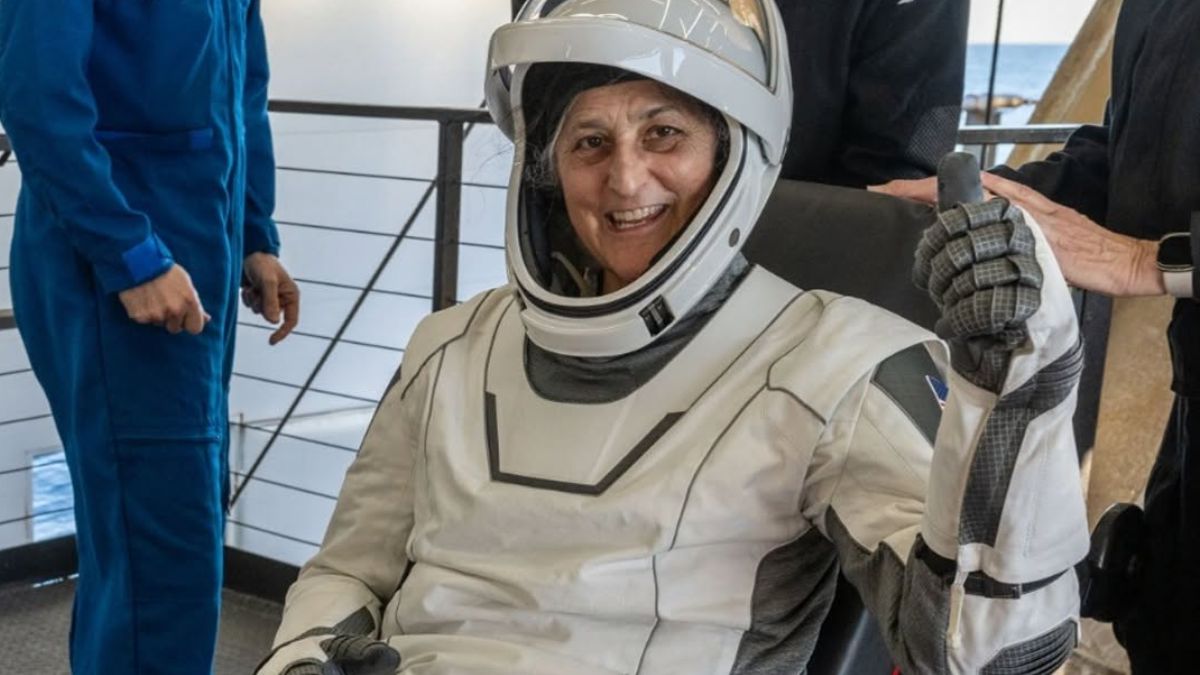After spending nine long arduous months in space, Indian-origin Nasa astronaut Sunita Williams and her fellow crewmates, including Butch Wilmore, are finally back on solid ground.
The SpaceX’s Crew Dragon capsule carrying the four astronauts made a safe splashdown in the Gulf of Mexico early Wednesday morning (IST), hours after leaving the International Space Station.
The landing took place off the coast of Tallahassee, Florida, putting their unexpected journey to an end.
Crew-9 had some surprise visitors Dolphins after splashing down this afternoon.🐬#sunitawilliamsreturn
— The Storm Chasers (@TStormChasers) March 18, 2025
pic.twitter.com/9NrFpUGBzh
Williams, 59, and Wilmore, 62, had been stranded on the International Space Station (ISS) since June 2024 after their Boeing Starliner spacecraft suffered technical issues, turning what was meant to be a short test mission into an extended stay.
But while the time in space is over, Williams’ transition back to life on Earth is just beginning. From medical evaluations to an intensive 45-day rehabilitation programme, here’s what lies ahead for the Crew-9 astronauts.
Immediate medical checks post splashdown
As Williams and her fellow astronauts splashed down off the Florida coast, recovery teams were quick to assist them out of the SpaceX Crew Dragon capsule. To ensure their safety, they were placed on stretchers for initial medical checks.
Welcome home, Sunita Williams and Butch Wilmore! After 286 days in the vastness of space, completing 4,577 orbits around Earth, you return as heroes. Your journey is a testament to human courage, resilience, and the boundless spirit of exploration. The world celebrates your safe… pic.twitter.com/bTBCrN7X95
— Dr Syed Naseer Hussain, M P (@NasirHussainINC) March 18, 2025
This is a routine procedure for astronauts returning from long-duration missions, as their bodies undergo significant physical changes in microgravity. After months without Earth’s gravitational pull, their muscles weaken, and bones lose density, making even simple movements challenging upon return.
Also read: Why gravity will be Sunita Williams’ biggest challenge after she returns to Earth
They also experience dizziness, instability, and fatigue as their body suddenly readjusts to the Earth’s gravity.
Another unusual aftermath of prolonged space travel is what’s known as “baby feet.” Over time, the calluses astronauts develop on their soles begin to soften and peel off due to the lack of friction in space. This makes their feet extra sensitive upon return—almost like those of a newborn.
They also face major changes in the cardiovascular system as without gravitation the fluids in the body shift upward toward the head.
Upon return, this fluid redistribution results in puffiness on the face, nasal congestion, and heightened pressure inside the skull. At the same time, the lower body experiences a deficit of fluids, making astronauts’ legs seem thinner and weaker. This phenomenon is called “puffy-head bird-legs syndrome”.
45-day rehab programme at Johnson Space Centre
After their initial medical checkups, Williams and her fellow astronauts will be flown to Nasa’s Johnson Space Center in Houston. There, they will spend several days undergoing rehabilitation programmes designed to help them readjust to life on Earth.
Specialists from the Astronaut Strength, Conditioning, and Rehabilitation (ASCR) team will oversee their recovery and will help them with their reconditioning, reports NDTV.
Rehabilitation begins immediately upon landing and continues for 45 days, with two-hour sessions every day, seven days a week.
The recovery process is divided into three phases. Phase 1, which starts on landing day, focuses on walking, flexibility, and basic muscle strengthening. Phase 2 introduces balance exercises and cardiovascular conditioning, helping astronauts regain coordination. Phase 3, the longest phase, is dedicated to functional development, ensuring they can perform daily activities without discomfort.
Each programme is tailored to the astronaut’s specific needs based on medical tests, mission duties, and even personal fitness preferences. Studies show that by the end of the rehab programme, astronauts not only regain their pre-flight fitness but, in many cases, emerge even stronger than before.
Post-mission debriefings
Once their recovery is complete, Williams and her fellow astronauts will likely take part in debriefings to reflect on their mission. These sessions will cover their experiences, experiments, challenges, and key takeaways from their extended stay in space. Their insights will help Nasa improve future missions, especially those involving long-duration spaceflight.
Williams is also expected to engage in public outreach. She will likely participate in educational programmes, motivational talks, and events aimed at inspiring the next generation of astronauts, engineers, and space enthusiasts.
Reuniting with family
After spending months in space, Sunita Williams is expected to prioritise time with her family and friends. Personal time is essential for an astronaut’s psychological well-being, helping them reconnect with loved ones and ease back into everyday life on Earth.
Williams has spoken about the simple joys she’s been looking forward to—long walks with her dogs and a refreshing swim in the ocean. Her husband, Michael J Williams, a retired federal marshal, has been caring for their two Labrador retrievers while she was away.
Also read: Sunita Williams returns to Earth: What is her connection to India?
In a press conference last year, she shared how much she missed her family, friends, and pets. “I know it’s tough for them too, being apart, but they understand, and everyone’s rooting for us to return with SpaceX Crew-9,” she said.
Meanwhile, her crewmate Butch Wilmore, an elder at his Baptist church, is eager to return to face-to-face ministering—and to once again enjoy the simple pleasure of smelling freshly cut grass.
With input from agencies


)

)
)
)
)
)
)
)
)



